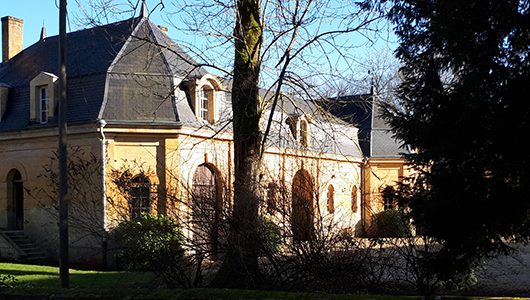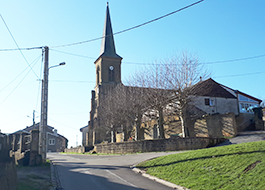Thonne-les-Prés
Durée visite : 25 minutes
Moyen : Pédestre
Les comtes de Chiny affranchissent le village au XIIIe siècle à la loi de Beaumont. Thonne-les-Près bénéficie alors de moindres taxes et d’une plus grande autonomie. Un château est construit au XIVe. En 1661, devenu français, le village est rattaché à la prévôté de Montmédy. Le nouveau château date du début du XXe siècle. Le 19 septembre 1815, les Prussiens, qui assiègent Montmédy, signent à Thonne l’armistice. En 1914-1918, un aérodrome allemand est installé sur le ban de la commune. Les avions y décollent vers le front de Verdun.
The counts of Chiny freed the village in the 13th century from the law of Beaumont. Thonne-les-Près then benefits from lower taxes and greater autonomy. A castle was built in the 14th century. In 1661, having become French, the village was attached to the provost of Montmédy. The new castle dates from the beginning of the 20th century. On September 19, 1815, the Prussians, who besieged Montmédy, signed the armistice in Thonne. In 1914-1918, a German aerodrome was set up on the outskirts of the town. The planes take off there towards the Verdun front.
Die Grafen von Chiny befreiten das Dorf im 13. Jahrhundert vom Gesetz von Beaumont. Thonne-les-Près profitiert dann von niedrigeren Steuern und größerer Autonomie. Eine Burg wurde im 14. Jahrhundert erbaut. Nachdem das Dorf 1661 französisch geworden war, wurde es dem Provost von Montmédy angegliedert. Das neue Schloss stammt aus dem Anfang des 20. Jahrhunderts. Am 19. September 1815 unterzeichneten die Preußen, die Montmédy belagerten, den Waffenstillstand in Thonne. In den Jahren 1914-1918 wurde am Rande der Stadt ein deutscher Flugplatz eingerichtet. Dort starten die Flugzeuge in Richtung Verdun-Front.
Les points de visites
.
Un ancien château existait déjà au Moyen Âge. En 1626, le prévôt de Montmédy, Guillaume de Crochart acquiert les terres et la seigneurie de Thonne-les-Prés. Il défend héroïquement la brèche du bastion Saint-André de la citadelle assiégée par Louis XIV en 1657. Son descendant, Frédéric-Jehannot de Crochart, trésorier des armées françaises en Espagne, et maire du village entre 1813 et 1828, reconstruit le château. Son petit-fils, le baron Albert de Benoist, l’embellit. De plan rectangulaire, il s’élève sur trois niveaux, dont le dernier est percé de mansardes.
Une orangeraie est édifiée à proximité au XIXe. Son orientation plein sud permet de capter au maximum les rayons solaires. Une chiennerie est construite à l’ombre du viaduc. Quatre petits bâtiments greffés sur un noyau octogonal abritaient les chiens. Une glacière est encore visible. Profonde de plusieurs mètres, elle conservait la viande jusqu’en juillet, grâce à de la glace. Celle-ci était ramenée de la grande plaine pendant l’hiver. Les vents dominants étaient captés par une tranchée. Leur souffle maintenait une fraîcheur constante.
Le viaduc est long de 870 mètres. Construit en 1860, pour la ligne des Ardennes avec du ciment belge, il est détruit en 1870, en 1914 et en 1940 par les Français pour ralentir l’ennemi.
An old castle already existed in the Middle Ages. In 1626, the provost of Montmédy, Guillaume de Crochart acquired the land and the seigneury of Thonne-les-Prés. He heroically defends the breach of the Saint-André bastion of the citadel besieged by Louis XIV in 1657. His descendant, Frédéric-Jehannot de Crochart, treasurer of the French armies in Spain, and mayor of the village between 1813 and 1828, rebuilt the castle. His grandson, Baron Albert de Benoist, embellished it. Rectangular in plan, it rises on three levels, the last of which has mansards. An orange grove was built nearby in the 19th century. Its south-facing orientation makes it possible to capture the sun’s rays as much as possible. A doghouse is built in the shade of the viaduct. Four small buildings grafted onto an octagonal core housed the dogs. A cooler is still visible. Several meters deep, it kept the meat until July, using ice. This was brought back from the great plain during the winter. The prevailing winds were picked up by a trench. Their breath maintained a constant freshness.
The viaduct is 870 meters long. Built in 1860, for the Ardennes line with Belgian cement, it was destroyed in 1870, 1914 and 1940 by the French to slow down the enemy.
Eine alte Burg existierte bereits im Mittelalter. Im Jahr 1626 erwarb der Provost von Montmédy, Guillaume de Crochart, das Land und das Seigneury von Thonne-les-Prés. Er verteidigt heldenhaft den Bruch der Saint-André-Bastion der Zitadelle, die 1657 von Ludwig XIV. Belagert wurde. Sein Nachkomme, Frédéric-Jehannot de Crochart, Schatzmeister der französischen Armeen in Spanien und Bürgermeister des Dorfes zwischen 1813 und 1828, baute die Burg wieder auf. Sein Enkel, Baron Albert de Benoist, verschönerte es. Im Plan rechteckig, steigt es auf drei Ebenen, von denen die letzte Mansarden hat.
In der Nähe wurde im 19. Jahrhundert ein Orangenhain gebaut. Die nach Süden ausgerichtete Ausrichtung ermöglicht es, die Sonnenstrahlen so gut wie möglich einzufangen. Im Schatten des Viadukts wird eine Hundehütte gebaut. Vier kleine Gebäude, die auf einen achteckigen Kern gepfropft waren, beherbergten die Hunde. Ein Kühler ist noch sichtbar. Mehrere Meter tief hielt es das Fleisch bis Juli mit Eis. Dies wurde im Winter aus der großen Ebene zurückgebracht. Die vorherrschenden Winde wurden von einem Graben aufgenommen. Ihr Atem bewahrte eine konstante Frische.
Der Viadukt ist 870 Meter lang. 1860 für die Ardennenlinie mit belgischem Zement erbaut, wurde es 1870, 1914 und 1940 von den Franzosen zerstört, um den Feind zu bremsen.
.
.
L’église saint-Georges date de 1874. Elle remplace un ancien sanctuaire incendié par les Prussiens en 1870. Son architecte, Adolphe Lagosse, lui donne un style néo-gothique. Son porche voûté possède un oculus. Un arc ogival décoré de raisins encadre la porte. Deux contreforts maintiennent la haute tour-clocher. En 1916, les Allemands confisquent les cloches pour les fondre. La famille de Benoist, châtelains du village et les habitants les font remplacer en 1920. Le mobilier est dû aux frères Manceaux, menuisiers au village.
The Saint-Georges church dates from 1874. It replaces an old sanctuary burnt down by the Prussians in 1870. Its architect, Adolphe Lagosse, gives it a neo-Gothic style. Its arched porch has an oculus. A pointed arch decorated with grapes frames the door. Two buttresses maintain the high bell tower. In 1916, the Germans confiscated the bells to melt them. The Benoist family, lords of the village and the inhabitants had them replaced in 1920. The furniture was made by the Manceaux brothers, carpenters in the village.
Die Saint-Georges-Kirche stammt aus dem Jahr 1874. Sie ersetzt ein altes Heiligtum, das 1870 von den Preußen niedergebrannt wurde. Der Architekt Adolphe Lagosse verleiht ihr einen neugotischen Stil. Die gewölbte Veranda hat ein Okulus. Ein mit Trauben verzierter Spitzbogen umrahmt die Tür. Zwei Strebepfeiler erhalten den hohen Glockenturm. 1916 beschlagnahmten die Deutschen die Glocken, um sie zu schmelzen. Die benoistische Familie, die Herren des Dorfes und die Einwohner ließen sie 1920 ersetzen. Die Möbel stammten von den Brüdern Manceaux, den Zimmerleuten im Dorf.







